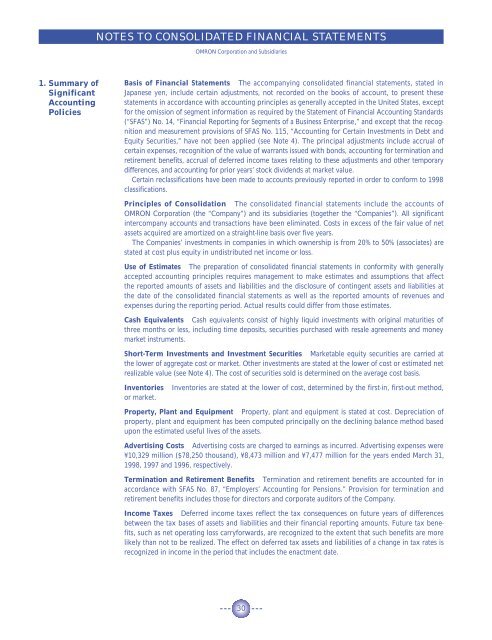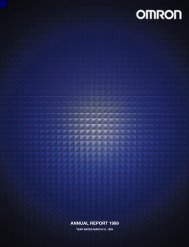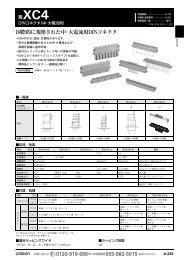Annual Report 1998 - Omron
Annual Report 1998 - Omron
Annual Report 1998 - Omron
Create successful ePaper yourself
Turn your PDF publications into a flip-book with our unique Google optimized e-Paper software.
NOTES TO CONSOLIDATED FINANCIAL STATEMENTS<br />
OMRON Corporation and Subsidiaries<br />
1. Summary of<br />
Significant<br />
Accounting<br />
Policies<br />
Basis of Financial Statements The accompanying consolidated financial statements, stated in<br />
Japanese yen, include certain adjustments, not recorded on the books of account, to present these<br />
statements in accordance with accounting principles as generally accepted in the United States, except<br />
for the omission of segment information as required by the Statement of Financial Accounting Standards<br />
(“SFAS”) No. 14, “Financial <strong>Report</strong>ing for Segments of a Business Enterprise,” and except that the recognition<br />
and measurement provisions of SFAS No. 115, “Accounting for Certain Investments in Debt and<br />
Equity Securities,” have not been applied (see Note 4). The principal adjustments include accrual of<br />
certain expenses, recognition of the value of warrants issued with bonds, accounting for termination and<br />
retirement benefits, accrual of deferred income taxes relating to these adjustments and other temporary<br />
differences, and accounting for prior years’ stock dividends at market value.<br />
Certain reclassifications have been made to accounts previously reported in order to conform to <strong>1998</strong><br />
classifications.<br />
Principles of Consolidation The consolidated financial statements include the accounts of<br />
OMRON Corporation (the “Company”) and its subsidiaries (together the “Companies”). All significant<br />
intercompany accounts and transactions have been eliminated. Costs in excess of the fair value of net<br />
assets acquired are amortized on a straight-line basis over five years.<br />
The Companies’ investments in companies in which ownership is from 20% to 50% (associates) are<br />
stated at cost plus equity in undistributed net income or loss.<br />
Use of Estimates The preparation of consolidated financial statements in conformity with generally<br />
accepted accounting principles requires management to make estimates and assumptions that affect<br />
the reported amounts of assets and liabilities and the disclosure of contingent assets and liabilities at<br />
the date of the consolidated financial statements as well as the reported amounts of revenues and<br />
expenses during the reporting period. Actual results could differ from those estimates.<br />
Cash Equivalents Cash equivalents consist of highly liquid investments with original maturities of<br />
three months or less, including time deposits, securities purchased with resale agreements and money<br />
market instruments.<br />
Short-Term Investments and Investment Securities Marketable equity securities are carried at<br />
the lower of aggregate cost or market. Other investments are stated at the lower of cost or estimated net<br />
realizable value (see Note 4). The cost of securities sold is determined on the average cost basis.<br />
Inventories<br />
or market.<br />
Inventories are stated at the lower of cost, determined by the first-in, first-out method,<br />
Property, Plant and Equipment Property, plant and equipment is stated at cost. Depreciation of<br />
property, plant and equipment has been computed principally on the declining balance method based<br />
upon the estimated useful lives of the assets.<br />
Advertising Costs Advertising costs are charged to earnings as incurred. Advertising expenses were<br />
¥10,329 million ($78,250 thousand), ¥8,473 million and ¥7,477 million for the years ended March 31,<br />
<strong>1998</strong>, 1997 and 1996, respectively.<br />
Termination and Retirement Benefits Termination and retirement benefits are accounted for in<br />
accordance with SFAS No. 87, “Employers’ Accounting for Pensions.” Provision for termination and<br />
retirement benefits includes those for directors and corporate auditors of the Company.<br />
Income Taxes Deferred income taxes reflect the tax consequences on future years of differences<br />
between the tax bases of assets and liabilities and their financial reporting amounts. Future tax benefits,<br />
such as net operating loss carryforwards, are recognized to the extent that such benefits are more<br />
likely than not to be realized. The effect on deferred tax assets and liabilities of a change in tax rates is<br />
recognized in income in the period that includes the enactment date.<br />
30




